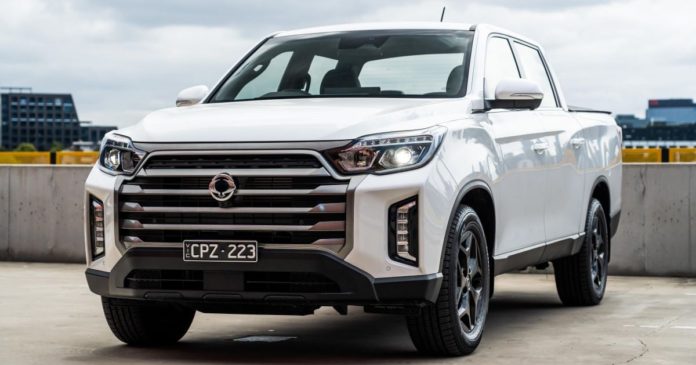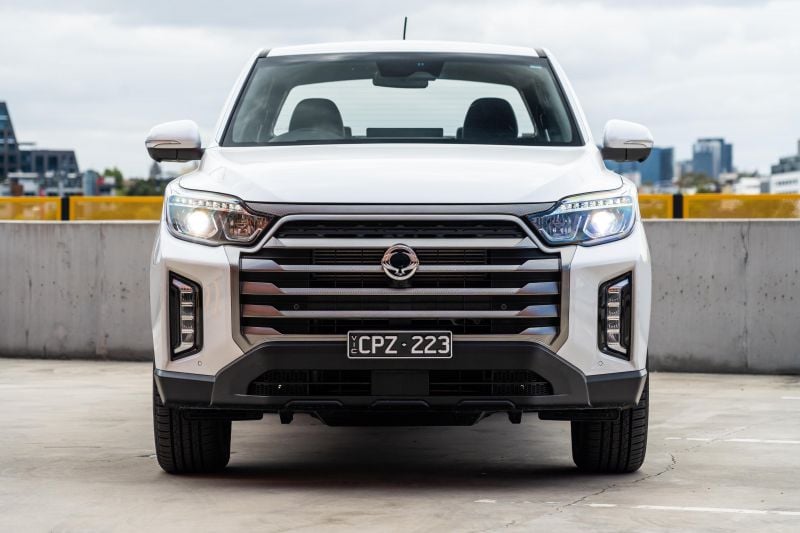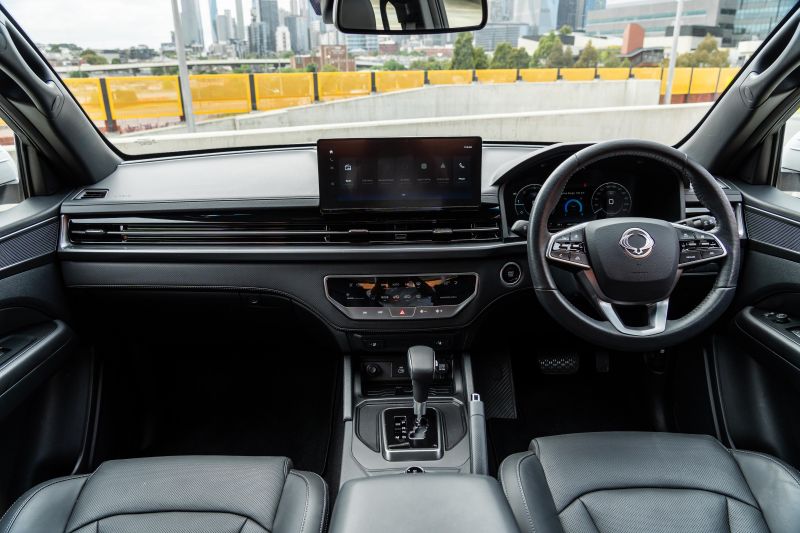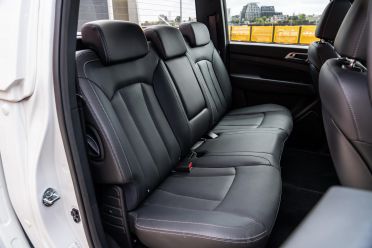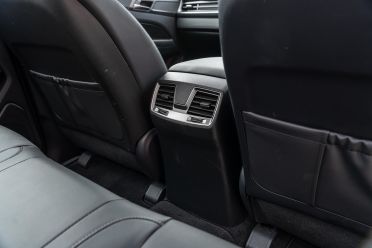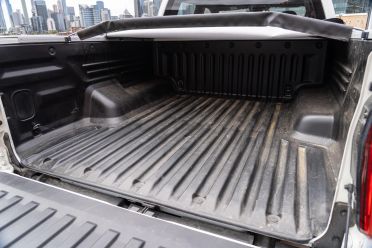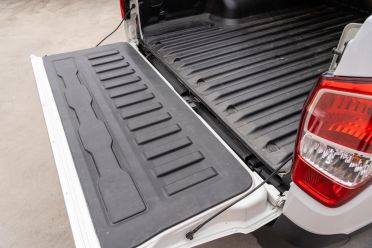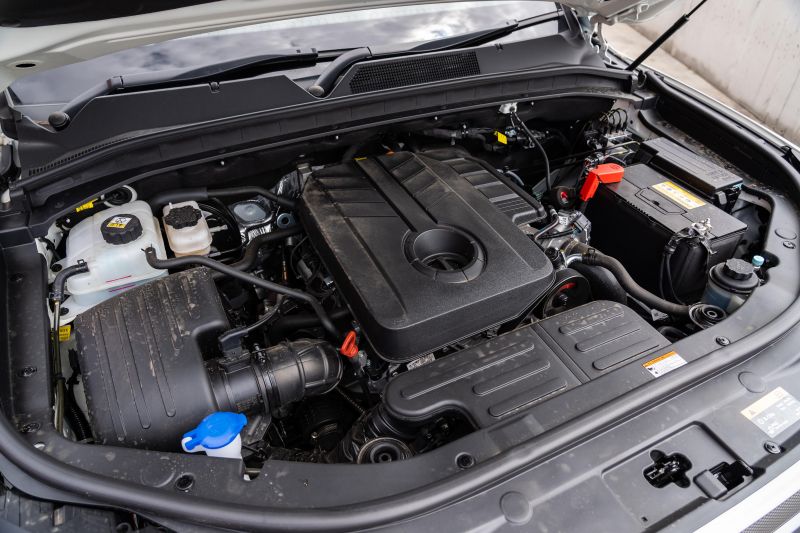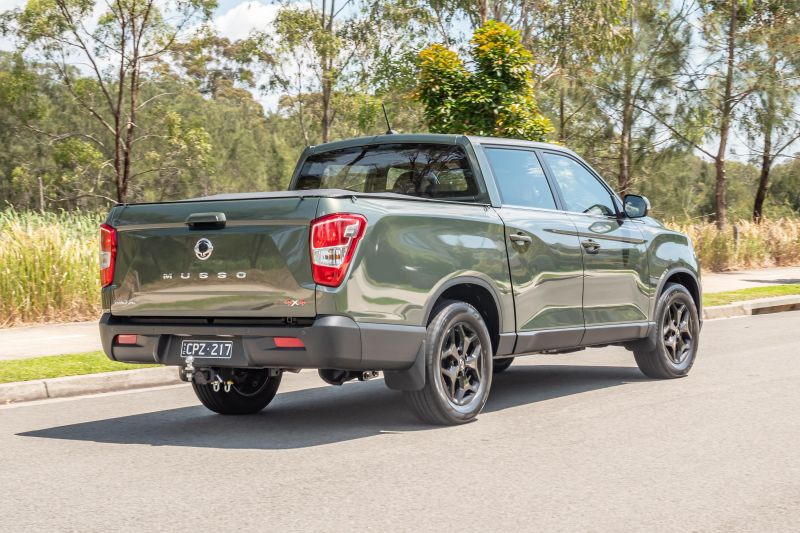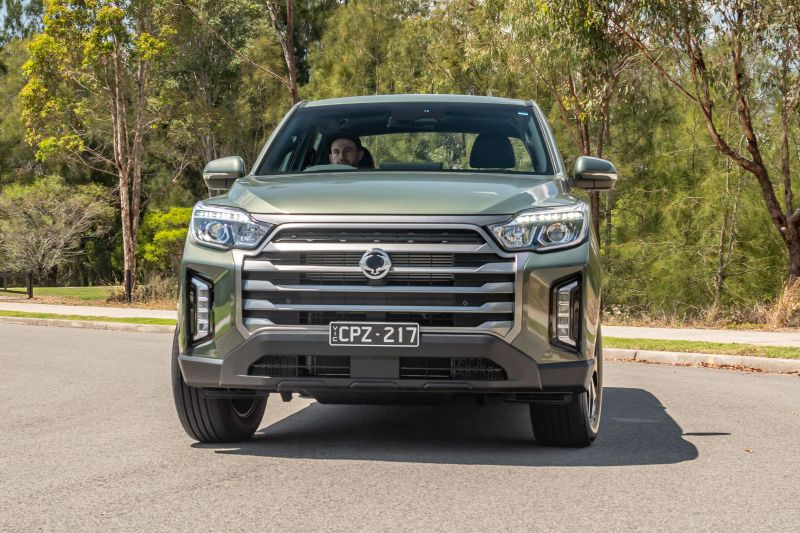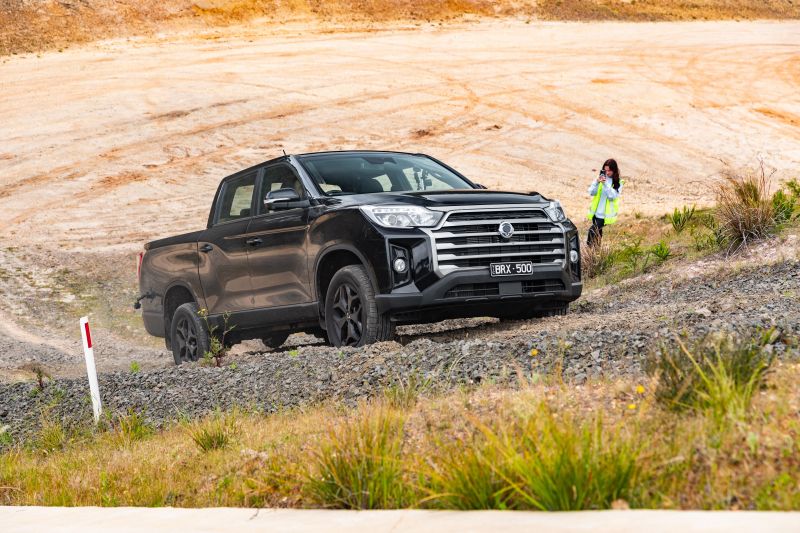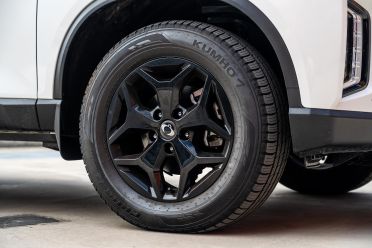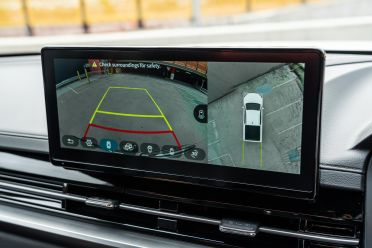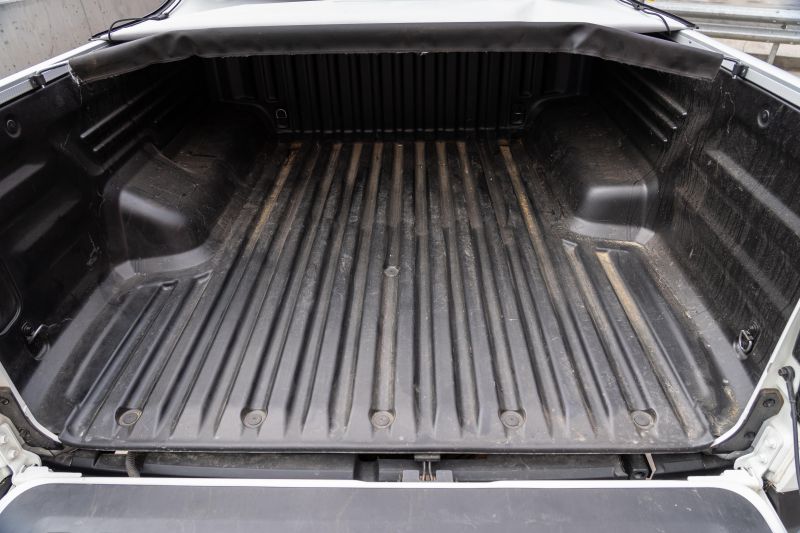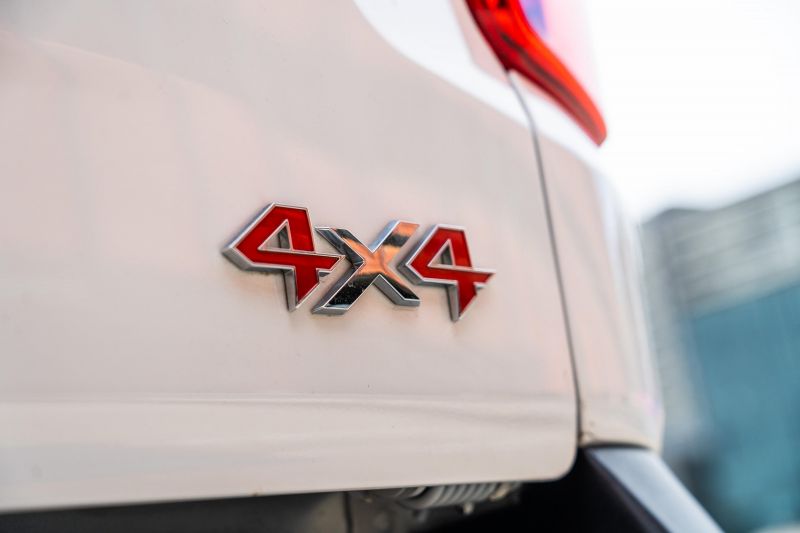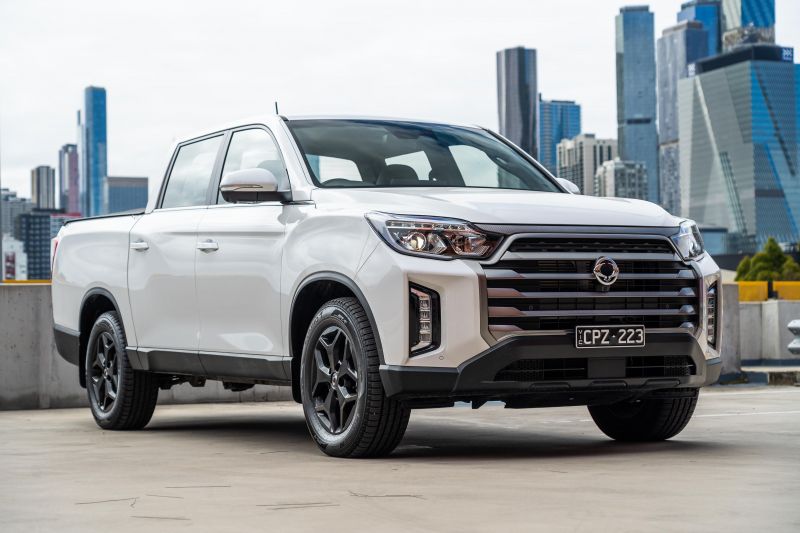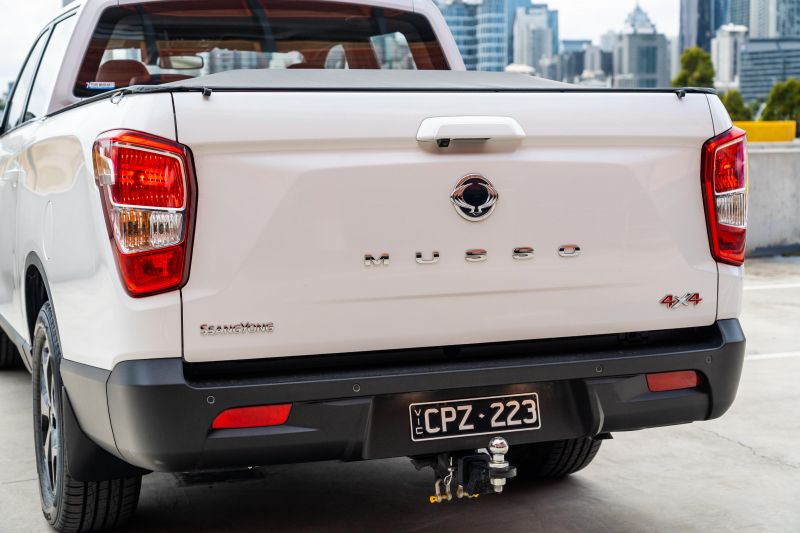Utes continue to dominate the Australian new car landscape, but some brands aren’t cashing in as much as others.
While it’s pretty cheap relative to the market-leading Ford Ranger and Toyota HiLux, the SsangYong Musso is a niche player in one of Australia’s largest automotive segments, with just 1.7 per cent segment share in 2023.
But that’s not necessarily a reflection of its talents. The Musso remains solid value for money as prices across the industry continue to creep up, and offers one of the more SUV-like cabin and drive experiences of the segment.
It was treated to some mild changes for 2024, bringing dual 12.3-inch displays in the cabin across the range, as well as an updated dashboard and a new mid-range Adventure variant.
The car you see here is the absolute flagship, the 2024 SsangYong Musso XLV Ultimate. Fully optioned, but with standard white paint, you’re still looking at just under $50,000 drive-away.
How does the Ssangyong Musso XLV compare?
View a detailed breakdown of the Ssangyong Musso XLV against similarly sized vehicles.

SsangYong
Musso XLV
How much does the SsangYong Musso cost?
On test we have the flagship 2024 SsangYong Musso Ultimate ($45,000 drive-away), decked out with the XLV Pack ($1500) and Luxury Pack ($3500).
2024 SsangYong Musso pricing:
- 2024 SsangYong Musso ELX: $40,000 (+$1210)
- 2024 SsangYong Musso Adventure: $42,500 (NEW)
- 2024 SsangYong Musso Ultimate: $45,000 (+$1910)
Prices are drive-away
To see how the Musso lines up against its rivals, check out our comparisons tool.
What is the SsangYong Musso like on the inside?
The MY24 Musso has some substantial changes in the cabin, with new displays and a revised dash design.
A pair of 12.3-inch widescreen displays now feature, bringing the Musso in line with the related Rexton SUV and making it more competitive against the current crop of rivals.
The digital instrument cluster in particular is more in line with what’s on offer in the passenger and SUV classes than anything commercial-leaning, and the fact it’s standard across the range is call for praise.
It offers high resolution, attractive layouts and fluid animations. I like that there are a range of themes, widgets and layouts, but it’s not quite as good as the high-grade digital cluster in the up-spec Ranger and Amarok.
Meanwhile, the 12.3-inch central touchscreen is less impressive. While a welcome increase to overall display real estate, it’s still limited in functionality – it has wired Apple CarPlay and Android Auto, but that’s about it.
Beyond your requisite Bluetooth and AM/FM radio functions, there’s little else the display offers. It’s a bit aftermarket, and reminds me of some of the new Chinese brands that have huge screens but have removed a lot of the functionality available in the domestic market.
The Musso otherwise offers a number of niceties, including powered leather seats that are both heated and ventilated up front; a powered sunroof, as well as heating for the outboard rear seats with the optional Luxury Pack.
It’s all pretty rare for the segment, let alone the price point. Comfort is generally pretty good, though the leather seat trim is a touch slippery and the front seats aren’t big on bolstering so there’s a bit of room to move – particularly given the high-set driving position.
While it’s high-tech in look, the plastic manual handbrake, maze-like shifter and limited frontal storage are quite old school.
SsangYong has rolled out touch-capacitive controls for the climate controls for this update as well, which work fine compared to some of the fiddlier systems on the market but can be a little annoying to adjust on the move – and the gloss black panel is also a fingerprint magnet.
There’s an interesting area under the centre stack that’s not really designed to hold larger phones, but there is a stand that allows you to have the phone sitting in landscape and holds it in place… most of the time.
At least there are dual USB-C ports there, as well as a pair of 12V power outlets. Toothed cupholders, a large lidded central cubby and a rotary 4WD selector round out the centre console features.
The rear seat is large enough for the Musso to make a comfortable four seater, and includes amenities like rear air vents and map pockets, as well as heated outboard seats if you get the Luxury Pack.
Leg- and headroom are good for taller adults even behind taller adults (I’m 6’1 and could sit behind my preferred driving position just fine).
But there’s a glaring issue though, the centre rear seat only has a lap seatbelt instead of a proper lap-sash restraint.
So, while there are three top-tether points and ISOFIX anchors on the outboard pews, the Musso has a key area for improvement if it wants to match rivals with this basic requirement as a five seater.
The rear ‘deck’ measures 1300mm long in standard guise, or 1600mm in the XLV tested here. Overall width is 1570mm with 1100 between the arches, while depth is a quoted 570mm.
SsangYong also quotes a capacity of of 1011 litres for the standard Musso, and 1262L for the XLV. Under the tray is a full size spare wheel, which is part of the reason the Australian-market Musso hasn’t moved to the latest iteration of the diesel powertrain available in Korea – the AdBlue tank means you can’t fit the spare.
What’s under the bonnet?
While there have been upgrades overseas, the Musso’s powertrain is carryover for 2024 in Australia.
| Model | SsangYong Musso |
|---|---|
| Engine | 2.2-litre 4cyl turbo-diesel |
| Power | 133kW @ 4000rpm |
| Torque | 400Nm @ 1400-2800rpm (420Nm @ 1600-2600rpm XLV) |
| Transmission | 6-speed automatic |
| Driven wheels | Part-time 4WD (2H, 4H, 4L) |
| Weight | 2110kg (kerb) |
| Fuel economy (claim) | 8.6L/100km (9.0L/100km XLV) |
| Fuel economy (as tested) | 9.2L/100km |
| Fuel tank size | 75 litres |
| Gross vehicle mass | 2880kg (2980-3220kg XLV) |
| Gross combination mass | 6380kg (6480-6720kg XLV) |
| Payload | 790kg (880-1010kg XLV) |
| Towing capacity (braked) | 3500kg |
How does the SsangYong Musso drive?
The updated Musso drives very much like the last one.
-
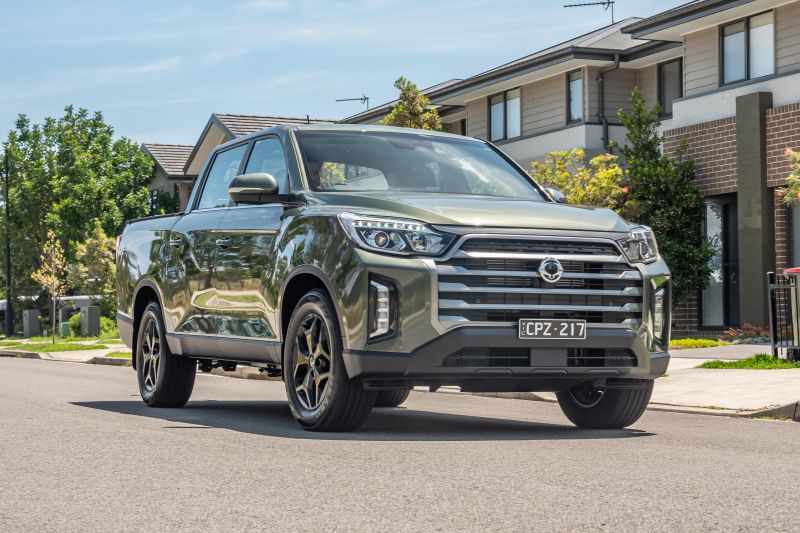
Musso Adventure shown
While sharing its chassis and running gear with the capable and confident Rexton, the Musso XLV’s more load-focused tuning means it’s not quite as comfortable in ride as something like a Ranger – though it’s not worst in class either.
It feels nice and softly sprung at the front, but impacts from expansion joints and the like reverberate through the structure particularly when driving unladen. That’s despite Adventure and Ultimate versions retaining a multi-link coil-sprung rear suspension system, compared to the base XLV EX’s heavy duty leaf springs.
It can also jiggle a bit at the rear even over relatively well-surfaced roads, and bounces around on rural roads. Body control on undulating roads is average, and there’s some kickback through the steering over mid-corner bumps.
Like most dual-cab utes, this can be easily addressed with having a load in the back. But given the Musso is arguably more lifestyle focused than some of its rivals, I’m not sure if a couple of hundred kilos worth of tools and equipment is going to live in the back of this – particularly in Ultimate Luxury Pack guise.
Where the SsangYong claws back ground is in overall refinement, with good insulation from powertrain noise as well as road and wind noise.
Unless you’re foot to the floor, the 2.2-litre oiler gets along without getting as vocal or rattly as a lot of the competition. It performs fine unladen, with good response and a smart shifting six-speed auto.
Performance is well suited to urban jaunts, with a torquey low and mid-range that means you don’t have to push too hard to get going – 420Nm available from 1600rpm is pretty handy.
The Musso offers a choice of Eco, Power and Winter drive modes, and you can manually shift gears by pushing the shifter to the left.
That’s not to say some extra grunt to match the 450-500Nm made by most rivals wouldn’t be welcome, and an extra one or two cogs in the transmission would be handy for the highway – the Rexton has an eight-speeder with the same drivetrain, so it would surely be fine here.
As commercial vehicles are continuing to adopt more sophisticated active safety and assistance systems, the Musso is starting to fall behind the pack, irrespective of price.
AEB, forward collision warning and lane departure warning are standard, as is a reversing camera with front and rear parking sensors. However, the Musso still lacks both adaptive cruise control and lane-keep assist – despite being available in the SsangYong overseas
The Ultimate tested here exclusively picks up blind-spot monitoring and rear cross-traffic alert, which is handy for that long booty of the XLV, and the surround-view camera makes parking this 5409mm long and 1950mm wide utility much, much easier.
We didn’t take this particular Musso off the beaten track, but here’s our findings from last year’s Dual Cab Ute Mega Test:
“The Musso XLV on test was fitted with the optional lime green ironman suspension upgrade. Like the Chevy Silverado the Korean eschews a manually-engaging rear diff lock, in favour of a self-locking unit that senses rotational slip.
The truth is, while we’d like the ability to control it ourselves, it works well – if a little abruptly. Just watch it slam into action and send the Musso chirping up the rollers, in 2H and 4H alike.
It worked similarly on the offset moguls, kicking the rear out when pushing the Musso out of its predicament. “Very effective,” said Paul. Just not subtle – “Give me a button”.
“Note this was the only vehicle on test that did not pass the flex test, with the driver’s door catching a little.
The Musso made an ok effort at Gravel Mountain in 4L with the auto-locker ready, battling and squirming about three-quarters the way up before losing traction.
Paul didn’t rate the downhill-descent control having to take over and commandeer the brakes, nor the tyres.”
MORE: Best off-road ute revealed
What do you get?
Musso ELX highlights:
- 17-inch alloy wheels
- Full-size spare wheel
- Automatic high-beam
- LED daytime running lights
- Front fog lights
- Rain-sensing window wipers
- Heated side mirrors with integrated indicators
- Assisted tailgate operation
- 12.3-inch digital instrument cluster
- 12.3-inch touchscreen infotainment system
- Apple CarPlay, Android Auto (wired)
- 6-speaker sound system
- 2 x USB-C ports
- Fabric upholstery
Musso Adventure adds:
- 18-inch black alloy wheels
- LED vertical front fog lights
- Speed-sensitive power steering
- Reach-adjustable steering wheel
- Leatherette upholstery
- Heated, ventilated front seats
- Tyre-pressure monitoring
Musso Ultimate adds:
- HID headlights
- Walk-up welcome system
- Touch-sensing front door locks
- Walk-away automatic door locking
- Heated steering wheel
- Blind-spot monitoring
- Rear cross-traffic alert
- Lane change collision warning
- Safe Exit Warning
- Surround-view camera
Options
A pair of key option packages are available depending on variant.
XLV Pack: $1500
- +300mm tub
- Rear leaf springs (ELX)
- Increased payload (1010kg EX, 880kg Adventure, Ultimate)
- Increased torque output (420Nm)
Luxury Pack: $3000 (Ultimate)
- Powered sunroof
- Dual-zone climate control
- Premium leather upholstery
- Power front passenger seat
- Driver power lumbar support
- Heated outboard rear seats
Colours
- Grand White
- Pearl White
- Amazonian Green
- Marble Grey
- Space Black
- Indian Red
Is the SsangYong Musso safe?
The current Musso hasn’t been crash tested by ANCAP or Euro NCAP.
There are two front airbags, front thorax airbags, and side head-protecting curtain airbags covering both seat rows. The centre rear seat still retains only a lap belt.
Standard safety equipment includes:
- Autonomous emergency braking (AEB)
- Driver attention warning
- Forward collision warning
- Lane departure warning
- Parking sensors front, rear
- Reversing camera
Musso Adventure adds:
Musso Ultimate adds:
- Blind-spot warning
- Rear cross-traffic alert
- Lane-change collision warning
- Safe Exit Warning
- Surround-view camera
How much does the SsangYong Musso cost to run?
The Musso is backed by a seven-year, unlimited-kilometre warranty.
Logbook servicing is required every 12 months or 15,000km, whichever comes first. The first seven services are capped at $375 each – not bad.
Our observed fuel economy of 9.2L/100km wasn’t far off the claim either, and would make for a theoretical driving range of just over 800 kilometres per fill.
CarExpert’s Take on the SsangYong Musso
If you want a budget-friendly ute that doesn’t feel like a workhorse inside, the Musso is still a solid pick.
With most rivals asking for tens of thousands more for similar levels of spec, the Musso Ultimate packs quite a bit of kit for under $50,000 drive-away, while also offering a relatively effortless and refined drive for a workhorse.
The option of two tub lengths is also handy, as is the 3.5-tonne maximum towing capacity, which the similarly attainable GWM Ute cannot match if you need something cheap that can tow. I will say, however, given some of the feature shortcomings and lack of a lap-sash rear seatbelt, it’s the lower grades of the Musso and Musso XLV that are more appealing.
The Musso XLV ELX is just $41,500 drive-away, and thanks to its heavy duty rear leaf springs offers a 1.0-tonne-plus payload and the same 3.5t towing capacity, while covering the basics in terms of standard equipment. It makes a lot of sense in this spec.
If you want some extra luxuries the Musso XLV Adventure scores heated and ventilated leather seats, tilt and telescoping steering wheel adjustment and flashier 18-inch alloys, and remains $5500 more attainable than this decked out Luxury Pack version.
Click the images for the full gallery
MORE: Buy a SsangYong Musso
MORE: Everything SsangYong Musso

